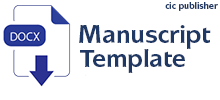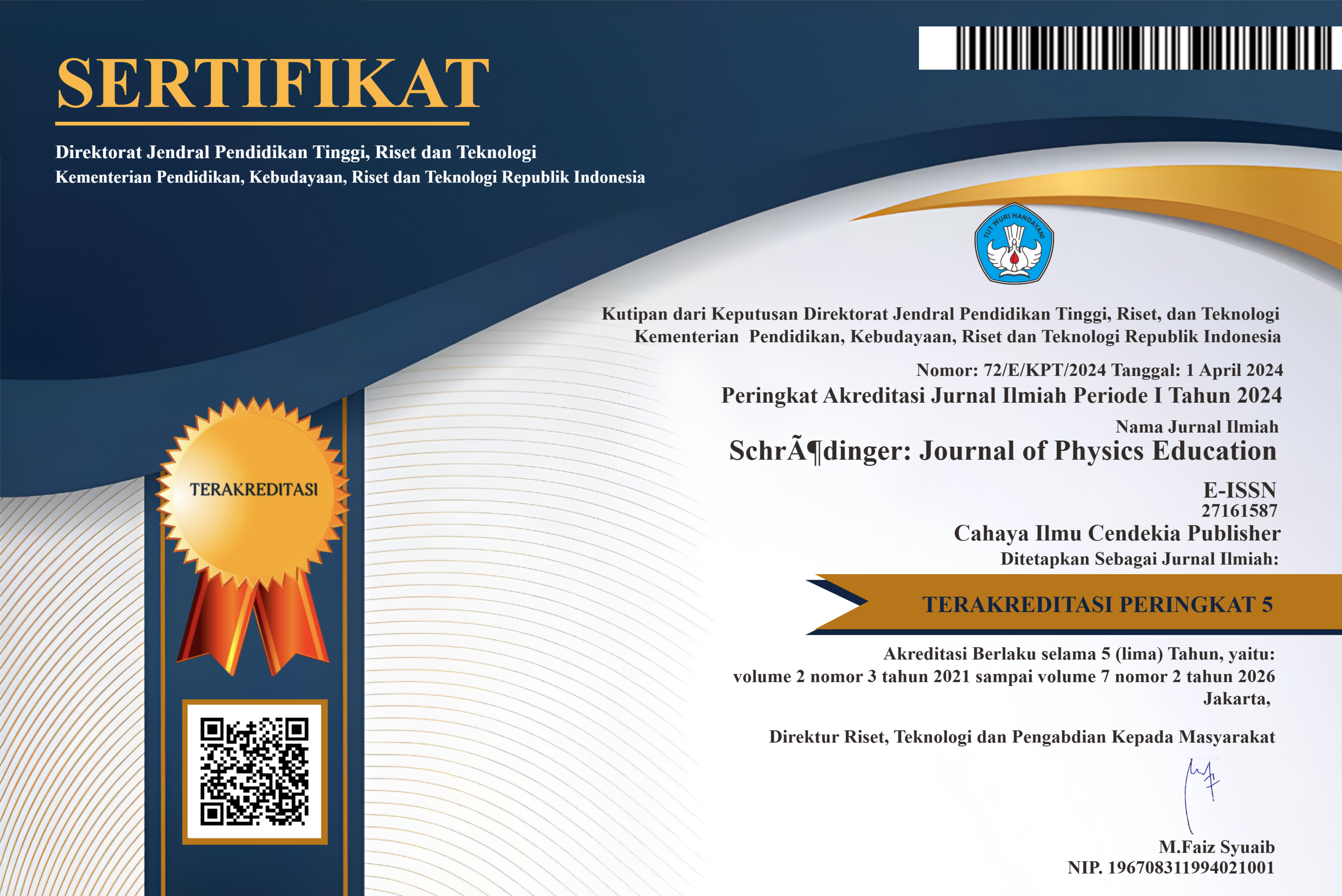The Effect of Implementing the Contextual Teaching Learning (CTL) Approach on the Formation of Students' Physics Behavior
Abstract
Purpose of the study: This research aims to determine the effect of implementing the Contextual Teaching Learning (CTL) approach on the formation of junior high school students' physics behavior.
Methodology: This research is quantitative research with associative causal type. The total research sample was 69 students with a sampling technique using purposive sampling. The instruments used in this research were questionnaires and interviews. The data analysis techniques used in this research are descriptive statistics and inferential statistics.
Main Findings: Based on the results of statistical analysis using SPSS 21, it was found that there was an influence of the application of Contextual Teaching (CTL) on the formation of physics behavior in class VIII SMP students with an influence percentage of 42%. With the regression equation Y = 45.508 + 0.363X. This means that if the CTL approach is not used in the physics learning process, the student's physics behavior score will be 45.508. Then, for every 1% increase in the level of the CTL approach, the physics behavior of class VII middle school students will increase by 0.363.l.
Novelty/Originality of this study: The findings of this research indicate that this approach in the teaching process is important to use as a means to increase the nuances of learning in the classroom to be more meaningful. The novelty of this research is that it is useful as a means of improving physics teaching and learning strategies in the classroom in order to shape students' positive behavior.
References
M. Dwi, W. Ernawati, A. Sanova, D. A. Kurniawan, and E. Triani, “Students ’ Attitude Towards Science and Its Implications on Science Learning Outcomes of Junior High School Students,” J. Pendidik. Progresif, vol. 12, no. 2, pp. 898–911, 2022, doi: 10.23960/jpp.v12.i2.20223.
Zurweni, D. A. Kurniawan, and E. Triani, “A Comparative study : Cooperative Learning in Science Learning,” J. Pendidik. dan Pengajaran, vol. 55, no. 1, pp. 115–126, 2022.
Kamid, D. A. Kurniawan, R. Perdana, B. Widodi, E. Triani, and P. Fadillah, “The Persistence Character and Math Processing Skills of Elementary School Students in Thematic Learning,” J. Ilm. Sekol. Dasar, vol. 7, no. 2, pp. 363–373, 2023.
E. Triani, Darmaji, and Astalini, “Identifikasi Keterampilan Proses Sains Dan Kemampuan Berargumentasi Siswa,” J. Pendidik. dan Pembelajaran IPA Indones., vol. 13, no. 1, pp. 9–16, 2023.
Playfair Eddie, “Education and the socially just recovery,” Forum Fam. Plan. West. Hemisph., vol. 64, no. 1, pp. 66–75, 2022, doi: https://doi.org/10.3898/forum.2022.64.1.06.
W. T. Wulandari, “Contextual Learning Approach : Development of Worksheet in Physics Subjects,” Schrödinger J. Phys. Educ., vol. 4, no. 2, 2023, doi: 10.37251/sjpe.v4i2.506.
S. Samsidar and T. Windianingsih, “Hubungan Minat Belajar Fisika Siswa SMA terhadap Materi Suhu dan,” Schrödinger J. Phys. Educ., vol. 3, no. 3, pp. 66–70, 2023, doi: 10.37251/sjpe.v3i3.508.
E. F. S. Rini and F. T. Aldila, “Practicum Activity: Analysis of Science Process Skills and Students ’ Critical Thinking Skills,” Integr. Sci. Educ. J., vol. 4, no. 2, pp. 54–61, 2023, doi: 10.37251/isej.v4i2.322.
R. Fitriani, L. Anatri, O. S. Joint, and R. Risnita, “Scope of Learning Evaluation in Science Subject in Junior High School Students: A Systematic Review,” J. Eval. Educ., vol. 4, no. 1, pp. 08–16, 2023, doi: 10.37251/jee.v4i1.307.
M. J. Liaghatdar, A. Soltani, R. Shojaei, and A. Siadat, “A study of current and desired state of physics education in iranian female secondary schools,” Int. Educ. Stud., vol. 5, no. 1, pp. 50–56, 2012, doi: 10.5539/ies.v5n1p50.
Mirawati and W. Sukarni, “Description of Student Attitudes : Enjoyment in Learning Physics and Interest in More Time Studying Physics,” SchrödingerJournal Phys. Educ., vol. 4, no. 1, pp. 1–6, 2023, doi: 10.37251/sjpe.v4i1.490.
F. R. Winda and M. Shofiardin, “Describing the Ability of Science Processes in Basic Physics Practicum II Material of Ice Melting Heat Using E-Modules,” SchrödingerJournal Phys. Educ., vol. 4, no. 1, pp. 18–23, 2023, doi: 10.37251/sjpe.v4i1.492.
A. Ekasari, “Application of E-Module to Identify Students ’ Science Process Skills in the Practicum of Refraction on Prisms,” SchrödingerJournal Phys. Educ., vol. 4, no. 2, pp. 30–35, 2023, doi: 10.37251/sjpe.v4i2.502.
M. Ilham and M. Gusrita, “Korelasi Sikap Siswa Kelas XI terhadap Hasil Belajar Fisika,” Schrödinger J. Phys. Educ., vol. 3, no. 2, pp. 43–46, 2023, doi: 10.37251/sjpe.v3i2.498.
A. Stender, M. Schwichow, C. Zimmerman, and H. Härtig, “Making inquiry-based science learning visible: the influence of CVS and cognitive skills on content knowledge learning in guided inquiry,” Int. J. Sci. Educ., vol. 40, no. 15, pp. 1812–1831, 2018, doi: 10.1080/09500693.2018.1504346.
D. Masniari. S, B. T. Turaqulov, and J. Kigo, “Attitude of Students’ Interest in Learning Physics,” Schrödinger J. Phys. Educ., vol. 4, no. 3, pp. 59–63, 2023, doi: 10.37251/sjpe.v4i3.697.
Samijo and D. D. Romadona, “A Study of Science Process Skills on Simple Pendulum Materials,” SchrödingerJournal Phys. Educ., vol. 4, no. 1, 2023, doi: 10.37251/sjpe.v4i1.494.
A. Asis, C. P. Ching, and W. Suttiwan, “Increasing Students’ Cognitive Absorption Through Remedial Learning in Physics,” Schrödinger J. Phys. Educ., vol. 4, no. 3, pp. 86–91, 2023, doi: 10.37251/sjpe.v4i3.709.
Alonemarera Alonemarera, S. Kaliu, Irawati, and Syamsul, “Contextual Teaching and Learning Approach: Study of Influence on Biology Study Participation of SMAN 1 Tinondo,” J. Biol. Edukasi, vol. 15, no. July, pp. 1–23, 2020.
Raimah, S. U. K. M. Siregar, and E. S. Nasution, “Penerapan Model Pembelajaran Contextual Teaching And Learning (Ctl) Dalam Meningkatkan Hasil Belajar Fisika Pada Siswa Kelas VIII MTs NU Sihepeng,” J. Pendidik. ILMU Pengetah. ALAM, vol. 1, no. 1, pp. 37–47, 2023.
A. Pangemanan, “Application of Contextual Teaching and Learning Approach on Statistics Material Against Student Results,” Int. Educ. Stud., vol. 13, no. 4, p. 1, 2020, doi: 10.5539/ies.v13n4p1.
J. Azwar, “The Analysis Of Need Islamic Learning Model To Improve The Effectiveness And Quality Of Islamic Religious Education In Stkip Pgri West Sumatera,” J. Pendidik. dan Pengajaran, vol. 50, no. 3, pp. 111–116, 2017.
J. C. C. Lorbis, “Utilization of Contextualized Teaching And Learning (CTL) Approach in Grade Two Araling Panlipunan,” Eric, no. April, p. 10, 2019, [Online]. Available: https://eric.ed.gov/?id=ED603874.
C. K. Ekowati, M. Darwis, H. M. D. P. Upa, and S. Tahmir, “The Application of Contextual Approach in Learning Mathematics to Improve Students Motivation At SMPN 1 Kupang,” Int. Educ. Stud., vol. 8, no. 8, pp. 81–86, 2015, doi: 10.5539/ies.v8n8p81.
Z. A. Rahmah and I. R. Ermawati, “Pengaruh Model Pembelajaran Contextual Teaching and Learning terhadap Hasil Belajar Matematika Siswa Sekolah Dasar,” J. Basicedu, vol. 6, no. 1, pp. 364–371, 2021, doi: 10.31004/basicedu.v6i1.1916.
L. Dewi and D. Dwikoranto, “Analisis Pendekatan Pembelajaran Contextual Teaching and Learning (CTL) Terhadap Peningkatan Hasil Belajar Fisika dengan Metoda Library Research,” PENDIPA J. Sci. Educ., vol. 5, no. 2, pp. 237–243, 2021, doi: 10.33369/pendipa.5.2.237-243.
Copyright (c) 2023 Ilyas Ilyas, Hina Kaynat, Aminu Salisu

This work is licensed under a Creative Commons Attribution-NonCommercial 4.0 International License.
Authors who publish with this journal agree to the following terms:
- Authors retain copyright and acknowledge that the Schrödinger: Journal of Physics Education is the first publisher licensed under a Creative Commons Attribution 4.0 International License.
- Authors are able to enter into separate, additional contractual arrangements for the non-exclusive distribution of the journal's published version of the work (e.g., post it to an institutional repository or publish it in a book), with an acknowledgment of its initial publication in this journal.
- Authors are permitted and encouraged to post their work online (e.g., in institutional repositories or on their website) prior to and during the submission process, as it can lead to productive exchanges and earlier and greater citation of published work.






.png)
.png)








.png)
.png)
.png)







